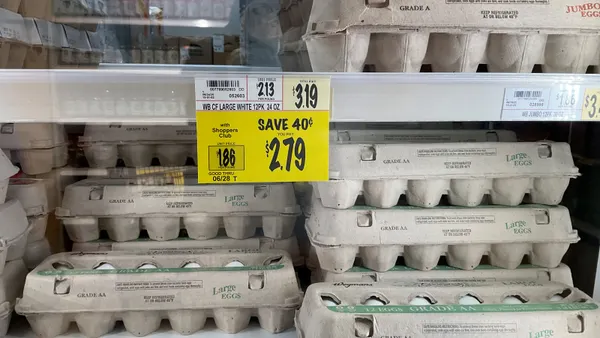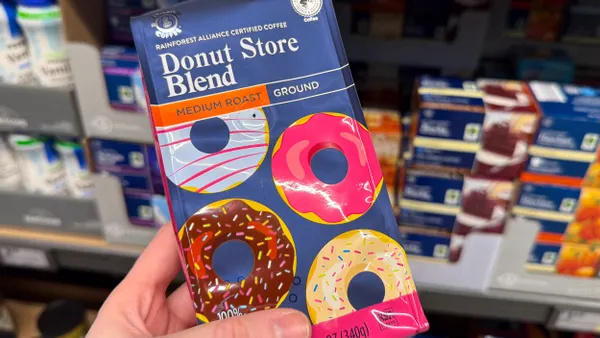Dive Brief:
- Meat is 50% more likely than the average grocery category to see a decrease in sales when restaurants reopen, according to Numerator's new Grocery Vulnerability Index, which aims to measure the impact that increased out-of-home dining will have on supermarkets and other food retailers as pandemic restrictions ease.
- Herbs and spices are 46% more likely to see a decrease in sales compared to other segments, while Numerator considers condiments (19%), packaged bakery (13%) and dairy (8%) as moderately vulnerable. Frozen foods along with baking and cooking ingredients are listed in the "wait and see" category, with slightly elevated risk of declines.
- Candy and shelf-stable meals are least likely to see a decline in grocery purchases, along with breakfast foods, canned foods, produce and alcohol.
Dive Insight:
Although consumers have developed a new affinity for cooking thanks to sheltering at home during the COVID-19 pandemic and restaurant closures, many are eager to partake in a culinary experience outside of the home. Restaurant dining is not just about the meal: It's about the atmosphere, social company, and other non-food-related factors.
Although figures from Numerator's Grocery Vulnerability Index may paint a grim picture for some segments like meat and herbs and spices, seven out of 10 consumers report that they plan to keep cooking at home even as restaurants reopen. This would help offset some of the decline in purchasing due to restaurant reopenings. Thanks to COVID-19, consumers have gotten more confident with their culinary skills, experimented with new cuisines or cooking styles and learned that at-home cooking can save money and boost health.
Other recent research from Numerator also holds positive news for meat. According to its Buyer Habit Index, beef and frozen meat buyers were more likely than the average category to have formed a repeat purchasing habit during the pandemic, giving some stickiness to the segment in a post-COVID-19 world. In fact, meat sales jumped more than 19% in 2020, according to data shared by the Food Industry Association and the Foundation for Meat & Poultry Research & Education, with beef having the greatest share of sales.
The fact that candy, shelf-stable meals, canned goods and produce are seeing low vulnerability from restaurant reopenings also speaks to consumers' new appreciation for cooking and keeping the pantry stocked. And as the pandemic has forced many to work from home, breakfast has become a new favorite for many consumers who are enjoying a chance to slow down and savor the morning instead of grabbing something portable to eat on their way out the door.
Wine and baking ingredients, some of consumers' biggest obsessions thanks to the pandemic, also enjoyed higher repeat purchases according to Numerator's Buyer Habit Index and so will also likely continue to find their way into consumers' carts even as restaurants reopen.
Other segments that have been impacted by the pandemic include frozen foods and dairy, but in different ways. Between November 2020 and November 2019, frozen food sales climbed 17.4%, according to data from IRI and the International Dairy Deli Bakery Association, outpacing sales for all other categories. The frozen segment offered quarantining consumers convenience when they wanted a night off cooking and an easy way to stockpile food at home to avoid supermarket runs and stay ahead of out-of-stock problems.
But whether consumers will keep their freezers full as restaurants reopen remains to be seen. Some may have discovered new frozen food items that they plan to keep in rotation while others may be eager to get back to freshly prepared foods and a restaurant experience. In a survey commissioned by Nestlé, 35% of consumers said they would likely bring a frozen meal to work for lunch, once their offices reopen.
The pandemic dealt a serious blow to the already struggling dairy segment, which relied on food service channels for much of its support and has seen an influx of competition from plant-based alternatives. As restaurants reopen, demand for dairy may once again increase, although Numerator expects this to be offset somewhat by a decline in at-home consumption and usage in recipes.











